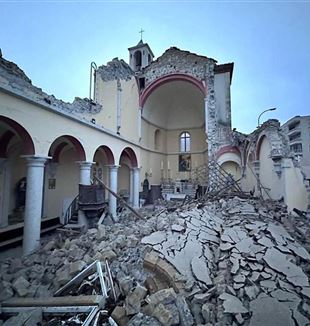
The wound of Aleppo
One of the most devastating earthquakes in Middle Eastern history. Thousands killed and wounded, in an area already tried by years of war. Yet "some already know where to start again."Mariam is from Aleppo. She was in bed when in the middle of the night the ground began to shake. "The walls were swaying. Through the cracks that formed, you could see outside. My husband, Nerwan, and I grabbed our daughters and ran towards the convent." She refers to the Latin parish of Aziezieh, managed by Franciscan friars, which during the war years became a focal point for many residents, both Christians and non-Christians.
Like Mariam and Nerwan, so many other families fled to the streets as the news piled up. Before long they realized they had survived one of the most devastating earthquakes in Middle Eastern history. More than 5,000 victims have been confirmed so far, and three times as many injured.
The epicenter was recorded in Turkey's Pazarcik district, in the southeast of the country, with a seismic tremor of magnitude 7.8 on the Richter scale. Cities like Gaziantep, Sanliurfa, Adana, Diyarbakir are have been left almost unrecognizable. Something similar has happened in the most affected areas of Syria-Aleppo, Homs, Latakia, Idlib, Tartous. To the drama of the earthquake on Syrian soil, we must also add eleven years of war and the poverty caused by the embargo and international sanctions. The difficulty now is to receive aid.
"People are digging with their bare hands with their cell phone torches; some have turned on car headlights to help locate people under the rubble. There is no electricity here except in certain areas and for a few hours a day. There are so many injured, few hospitals that are in a poor condition. The dead…we don't know," says a surviving woman in her 50s. In her city alone, as of yesterday afternoon, there were more than two hundred dead. Among them was a priest, Fr. Imad Daher, who had already survived a bombing a few years ago, as recalled by the Apostolic Nuncio to Syria, Cardinal Mario Zenari, who is visiting Aleppo today.
Whole families wander the streets in shock. The greatest fear is the aftershocks. The first 72 hours are decisive, seismologists say, as there could be more aftershocks of greater intensity. In their minds, they all go back to the months of incessant bombing, lived in anguish of not knowing where and when it would happen again. And then it is cold, very cold.
"We will need all the help we can get. We need blankets. It's raining. Temperatures are near zero, and there is no heat or light here. And above all, food and water are needed," explains Giacomo Pizzi, a worker with Associazione Pro Terra Sancta, an NGO of the Custody of the Holy Land that has been in the country for years supporting the population.
The church's bell tower collapsed and the stones destroyed a plexiglass canopy that had been painstakingly built thanks to many donations from abroad, to allow children and youths to play even when it rains. "It seems like something small, but when I saw how the destroyed roof, I was taken aback. What are we here to do? What are we rebuilding if then everything is destroyed again in a second? Then I saw the people who survived spontaneously gather in the church to thank God that they were alive. They already knew where to start again," Giacomo concluded.
The parish immediately arranged to accommodate the many families left homeless. In the basement, where children usually gather for after-school activities, a large number of households have now found shelter. Christians and Muslims. The first possible help was precisely to offer a roof and a hot meal, which has been the hallmark of the Franciscan mission in these areas since the war broke out.
For Pizzi, "It feels as if we have been catapulted back to the time of the Benedictines, when people looked to their monasteries as fundamental centers for daily life. Here in Aleppo, in Knayeh, in Yacoubieh ... people immediately flocked to the monasteries because they have light, gas and above all they can accommodate."
A very difficult, very complicated moment of emergency is now beginning. The years of war have worn down the country's social and economic fabric, resources are scarce, food and medicine are lacking, and many hospitals are not equipped. In contrast, the Saint Louis Hospital that has been operating since 2017 thanks to the AVSI Foundation, is working. "Our hospital has not suffered major damage,” explains its manager Georges Nasrallah. "We have stopped ordinary activity to receive the wounded and immediately treat the most serious cases." A titanic feat, in a country where doctors and nurses are now almost non-existent (so many have fled abroad since the early years of the war) and where being treated is now a luxury.
Several campaigns have been launched to help the wounded and displaced thanks to Pro Terra Sancta, AVSI, Caritas, among others. But Fr. Bahjat Karakach, the parish priest of Aziezieh, asks for a message to be spread: "We Franciscans have set out to help those who are left homeless and without food. There is damage in many cities, it is an earthquake that has affected a very large area. But we are making an appeal for sanctions to be lifted from Syria so that we can rebuild and really help those in need."